
|
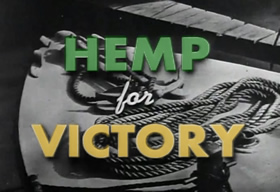 DURING THE SECOND WORLD WAR |

|
|---|
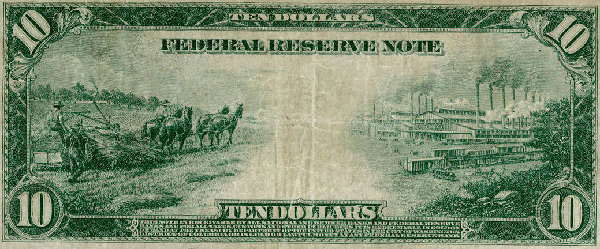
Note that the farmer is harvesting a Hemp Crop
3.0 - AMERICA'S HOME GROWN HEMP INDUSTRY
-- ITS ECONOMIC DECLINE
CHAPTER SUMMARY:
In the last chapter we went over (in a shortened form) the economic importance, both civilian as well as military, of hemp cultivation to this country’s history. In this chapter we go over it’s decline, but not in terms of either its civilian or military importance, nor even its economic importance to manufacturers. But simply its decline as an American Home Grown Crop. ----- The reason, in two words; “Cheap Imports”.
Before starting however, the reader should be warned that some (not all, but some) of what is put down here is opinion. And opinion, for good or for bad, is not established fact. But be that as it may (due to the nature of the subject) opinions simply cannot be avoided. Just be aware that not all historians share the same opinions as to exactly what happened.
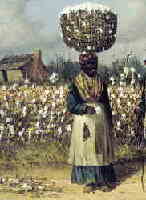
|
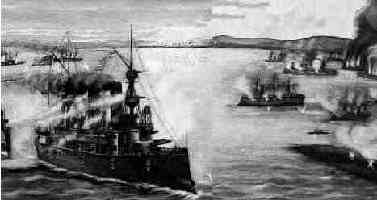 |
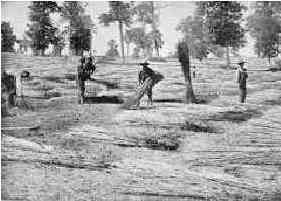
|
|---|
3.1 - THE FORCES THAT LEAD TO DECLINE
There are many who believe that it was (what we now know of as) the Reefer Madness Hysteria Campaign, that brought about the decline and end of America’s Home Grown Hemp Industry. However, I personally am of the opinion that by the time reefer madness came around, our Hemp Industry (for a myriad of reasons), had already declined to such an extent, that it was nothing more then a mere shadow of its former self. Had it been otherwise, Anslinger’s Reefer Madness Campaign would have been stopped dead in its tracks. After all, just ask yourself, “How would it have been possible to demonize (as the Weed of Madness), what was being grown on the farm next to yours?” What was being grown on hundreds of farms all around you? The answer is obvious; you couldn’t.
BUT then this situation begs an obvious question. As noted in previous sections, Hemp at one time played such an important role in this country’s economy that it was even against the law for farmers not to grow it So WHAT HAPPENED? How or why did this vital commodity become so irrelevant by the time the Second World War came around little if any actual growth was taking place? The answer lies not any one thing, but a myriad of technical and political factors; To which (It’s assumed no one wants to read a four volume dissertation on the subject) we will cover but a few:
3.1.1 - KING COTTON:
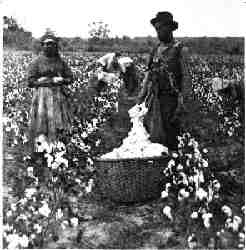
--- In 1794 Eli Whitney invented the cotton gin, which allowed for the separation of Cottonseeds, etc., from the actual cotton fiber, which PREVIOUSLY was a very, very, time consuming (meaning expensive) process. This factor cannot be underestimated. For as anyone who has ever worn a new shirt made of flax can testify, nice soft cotton is king. However (again, before the cotton gin), cotton was a very, very expensive fiber. Fine and well for the nobility, but just not economically practical for the common person out on the street. However, after the invention of the cotton gin the price of cotton started to drop and drop. Soon it was the dominant fiber for clothing.
However, while being a gentler fabric (good for shirts, underwear, etc.), because of its very gentleness (or weakness if you will) it was a poorer material for ropes, twine, blue jeans, sailing canvases, and other industrial uses etc., ---Thus cotton, while a factor was far from the only one.
3.1.2 - PULP PAPER MFG.:
- Although paper had long before been made from human grown/cultivated crops such as cotton and Hemp, by the mid-19th Century, inventors started to figure out how to make it directly out of wood pulp or sawdust. Although debatable, in the author’s opinion it was a couple of French guys around the 1880’s, who figured out how to put the last pieces of the process together. And, let’s face it, by anyone’s account, sawdust (which was previously probably being thrown away), was a whole-lot cheaper then Hemp being specifically grown for that task.
3.1.3 - PETROLEUM OIL:
- It is just a fact that the original automobiles were designed to run on peanut, cotton and hemp seed oil. However, petroleum (which at the time was much, much cheaper) quickly became a replacement. In addition, petroleum oil also replaced Hemp oil for lamps etc., at about this time.
3.1.4 - PLASTICS:
- Contrary to what most people think, the first plastics (which is a generic term) were developed in the 1890’s. And granted, it took a while for them to develop into full-fledged products, still the handwriting was already on the wall for Hemp twine and rope. By the time the Second World War came around, nylon (1935) had already been out for several years.
3.1.5 - LABOR COSTS:
--- Hemp has always been a labor intensive crop, so much so that in 1815 Thomas Jefferson (Yes that Thomas Jefferson), wrote the following:
"Hemp...is abundantly productive and will grow forever on the same spot, but the breaking and beating it, which has always been done by hand, is so slow, so laborious, and so much complained of by our laborers, that I have given it up, . . . ; and in the mean time a method of removing the difficulty of preparing hemp occurred to me, so simple and so cheap, that I return to it's culture and manufacture. To a person having a threshing machine, the addition of a hemp break will not cost more than . . . “ -- Dec. 29, 1815 In a letter from Thomas Jefferson to George Fleming.Labor intensive here can be thought of as nothing more than a nice term for E-X-P-E-N-S-I-V-E. According to one article (dealing with slavery) [A]
“. . . it was almost impossible to hire workmen to break a crop of hemp because the work was "very dirty, and so laborious that scarcely any white man will work at it," and he continued by saying that the task was done entirely by slave labor. “And while other crops, such as cotton were also labor intensive, due to various factors, it was able to adapt.
3.1.6 - THE PHILIPPINES & CHEAPER IMPORTS:
But it appears that the “Coup-De-Gras” was finally delivered by the Spanish American War.
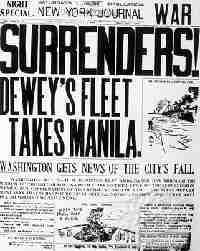
--- America has always had a problem with high labor costs. A factor that explains why we started importing foreign Hemp (around the 1930’s) as a raw material for our Industrial manufacturers. Then in 1898 the ultimate horror occurred. The Philippines were annexed and with it, it’s much cheaper to produce Manila Hemp plantations and without tariff protections American Hemp farmers just couldn’t compete with the cheaper imports.
The list of factors that lead to America’s Home Grown Hemp decline can go on and on, but I feel the reader gets the idea, hemp simply couldn’t economically compete with other sources of fiber at the time. The following, taken from the 1900 census clearly describes the problem.
“Hemp production in the United States reached its highest point in 1859, the decline since that time being 137,235,370 pounds, or 92.1 percent. The last decade showed a decline of 11,271,370 pounds, or 49.0 per cent. There are several reasons for the decline, among which are the introduction of manila hemp, the large importation of jute, the decline in prices of hard cordage fibers such as sisal and the use of cotton for twine and yarns." ---US. 1900 Census (Statistics of Agriculture) - pg 420 [dd]Thus it was a lot of factors WELL BEFORE the coming of the Reefer Madness campaigned that played a role in its demise. To quote an article (1931) as per the Charleroi (Pa) Mail:
Charleroi Mail 1931-06-11p7In other words, it was a lot cheaper to import the stuff from the Philippines, using Filipinos who (ah) were in many cases still working on the plantation. Meaning America's Home Grown Hemp Production (while still active at the time), was by now, only a shadow of its former self. Just at about the same time that the Reefer Madness Campaign was beginning to pick up steam.
EXPERTS SEE NO FUTURE FOR HEMP PRODUCTION
"Hemp, once a profitable crop in this country, has dwindled in importance, and the vehicle through which it has lost its market was the principal market in former years. It is estimated that in the early Colonial days it took the product of 1,000 acres of hemp to make the ropes necessary to outfit a single sailing vessel of any size.
Now ships bring Jute from India and this importation, due to its much lower price, has driven hemp from the market to a large extent. In spite of this loss of market, glowing pictures of prosperity to be had from hemp growing are painted for farmers who have had no experience, with the crop. Agents with something to sell have induced many farmers to attempt crops, but little hope of success is held out by Department of Agriculture officials, who point out that by no means Is the general run of land suitable for hemp production, even if it were, there still remains the fact that the demand for hemp is more than filled by present sources, with the result that the prices are too low to make a crop an attractive financially for the grower. —Washington .Star."
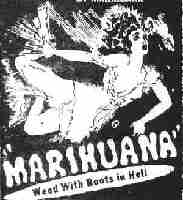
|
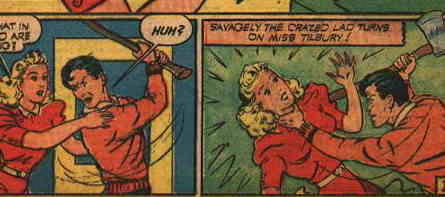 |
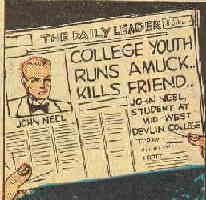
|
|---|
3.2 - AMERICA'S HOME GROWN HEMP INDUSTRY
ENTERS THE REEFER MADNESS CAMPAIGN
Despite the title, here we are NOT going to actually deal directly with the Reefer Madness campaign. One of our main websites: -- www.ReeferMadnessMuseum.org; – already does a pretty good job at that. Instead (as our focus is on the Hemp Industry during WW-II), we'll use this opportunity to cover some of the social-economic factors that existed just before America's entry into the war.
In previous sections, we've briefly covered both the economic as well as military, significance that our nations Home Grown Hemp sector (historically) played, as well as why our home grown agricultural sector had fallen on such hard times and into decline. So much so that even by the time of the First World War (which had caused major shipping/supply disruptions) America, which had already gotten into the habit of importing most of its cordage materials, began to face its first major shortages. To quote Utah’s Logan Republican:
Logan Republican (Utah) June 25, 1918p7Which again goes a long way to show the root cause of the problem. Hemp was still being used by our Industries, yet American farmers were not growing anywhere near our needs. And needless to say, there were many like the Mexican Sisal monopoly that were more than willing to take advantage of this fact:
Difficulties in Increasing Supplies of Hemp
The cutting off of supplies of hemp from Russia the Increasing difficulties in securing hemp from Italy, and also the difficulty In obtaining Jute from India, makes it imperative that more hemp be produced In the United States according to U. S. Department of Agriculture" officials. . . . more . .
GrandForksHerald1917-02-16p8Read the full article
American Hemp -- A PROFITABLE CROP—AND A WEED FIGHTER.
(By J. G. Haney, Agri. Exten. Dept., International Harvester Co.) Hemp adds another crop, and has proven more reliable than all other crops, excepting alfalfa and sweet clover. More than $80,000,000 leaves the United States each year for fibre used In binder twine. We can grow hemp at a profit and keep this money at home. Binder Twine is high because the Sisal Monopoly of Yucatan, Mexico, controls the output and has boosted the price, and will put it higher unless we grow hemp and "bust" them.
The United States Senate Committee reported the following facts:
"American farmers should make every effort to find a suitable substitute for sisal which can be grown in the United States in order that they may defy the foreign monopoly.
"There is active competition and no monopoly or combination in the sale of binder twine.
"The price of twine is based on the cost of the raw material. The manufacturers of twine have not made an exorbitant profit.
"The Yucatan Sisal Market was competitive until the Reguladora (Sisal Trust) obtained control. Smaller manufacturers and state prisons purchased their raw material as cheaply as the Plymouth Cordage Co., and the International Harvester Company. . . " more
(It makes for a good read)
Yet despite these efforts at the Federal level, most farmers simply looked the other way. Simply put Hemp just wasn’t profitable enough and too labor intensive to make it worth their while. Besides we controlled the Philippines at the time (including their many plantations) which were chuck full of (ah) cheap labor. And, just as expected, as soon as peace times returned the critical war (WW-I) shortages were quickly over. Thus there was no real need to re-establish our war time Home Grown Hemp production.
It was during this period of peace (1920’s-1930’s, or in between the two wars) that the Reefer Madness Hysteria campaign took place. And while true, there were many old farmers out there who would have remembered the old days and probably had a good laugh. Recalling that the decline started around the 1870’s, we should note that they were (even then) becoming few in number. Also it is important to note that the Reefer Madness campaign seems (while being inspired by the land of cotton) to have gotten its start in places like the southwest where few if any Hemp production had ever taken place.
Once established in the public mind that (what was now being termed) Marihuana was a deadly drug that made Black People go out and rape White Women; As well as the Federal Governments involvement in the campaign. Then things began to change and change fast. Soon state laws (masquerading as drug control laws) began to outlaw what was already an unprofitable crop; meaning there was no one there to stop them. And why should anyone have opposed the anti-Marihuana laws? After all would our own police lie to us? Would they go around saying that Marihuana made you into a cold-blooded killer if it weren’t true?
And while true, in the nineteen twenties and thirties, most assuredly there were older farmers who had previous hemp growing experience as well as a few who were still actively cultivating the crop. Farmers who (we can safely presume) spoke out defending hemp, but to little avail. After all, who was going to accept the word of a relatively small group of farmers (out in the middle of the backwoods) as oppose to that of our Federal Agents, and paid doctors, and law enforcement officials, and layers, and judges, and. . .all of whom were saying that Marihuana was a killer drug. About the most these farmers (as well as a few Industrial manufacturers) were able to obtain were a few production exceptions. Exceptions that (looking back on them with 20/20 hindsight) were only meant (to exist) for a short period of time.
Thus, shortly after America’s entry into the war, America found itself in a somewhat awkward situation where our industries required large quantities of cordage materials BUT COULD NOT OR WOULD NOT produce them. Thus forcing our manufacturers to rely heavily on imports. As well as a nation still in the throws of a hysteria campaign (lead by respectable members of our communities) that had not only succeeded in passed laws against the very presence of Industrial Hemp, but made many weary of having anything to do with it. After all, do you want your child to end up a cold-blooded murderer or have your daughter jump out of a fifth story window?
===============
CHAPTER 3
FOOTNOTES
[A] - http://druglibrary.org/schaffer/hemp/history/slavery.htm
[B]- COURTESY - By Tropenmuseum, part of the National Museum of World Cultures, CC BY-SA 3.0, https://commons.wikimedia.org/w/index.php?curid=8604613
WANT TO KNOW MORE:
=====================
Due to space / download time considerations, only selected materials are displayed. If you would like to obtain more information, feel free to contact the museum. All our material is available (at cost) on CD-Rom format.
CONTACT PAGE
 FOR VICTORY PRIVIOUS SECTION |
 |
 FOR VICTORY NEXT SECTION |
 BACK TO MAIN PAGE GROWING HEMP DURING THE WAR |